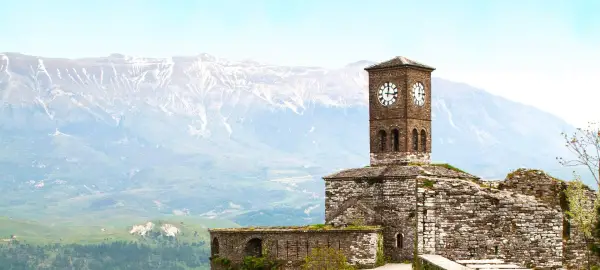PLEASE NOTE: We will be CLOSED on Tuesday, 11 November for Remembrance Day (Canada), and will be back to full operation from Wedneday the 12th. Book online anytime via this website; email sales@adventures-abroad.com to reach out.
- Overview
- Info & Inclusions
- Itinerary
- Map & Hotels
- Photos
- Dates & Prices
- Max Group Size 18
- Plitvice Lakes & Ohrid UNESCO World Heritage sites
- Stunning Julian Alps & Lake Bled
- Dubrovnik's medieval walls & "Pearl of the Mediterranean"
- Roman archaeological sites at Butrint & Apollonia
- Ottoman heritage in Berat, Gjirokastra & Mostar
- Scenic Albanian Riviera & North Macedonia's cultural treasures
- Singles friendly (view options for single travellers)
Our journey will take us from Croatia's sun-drenched Dalmatian islands to Albania's hidden archaeological treasures, where Roman amphitheatres and Ottoman architecture tell stories of empires that once shaped this crossroads region. We'll cross into North Macedonia to witness the rebuilt Ottoman bridge of Mostar, explore the "museum cities" of Berat and Gjirokastra, and conclude at Lake Ohrid, where ancient monasteries and Byzantine heritage create one of Europe's most spiritually significant destinations.
- Full-time Tour Leader services plus local guide support at several locations
- Breakfast and dinner (hotels & local restaurants) daily
- All transport, accommodation, sightseeing and entrance fees for sites noted as 'visited' in the detailed itinerary
- Gratuities for local guides, drivers, restaurant staff, porters
- Airport arrival/departure transfers for Land & Air customers and for any early arrivals/later departures should you book both your air and extra nights through us
- International airfare to/from the tour
- Tour Leader gratuities, lunches, drinks, personal items (phone, laundry, etc), international air taxes (if applicable), excursions referenced as 'optional'
- Airport transfers for Land Only customers
- Optional travel insurance
- Seasonality and Weather:
This tour is offered in spring and fall when Slovenia, Croatia, Bosnia-Herzegovina, Albania, and North Macedonia enjoy mild temperatures and comfortable traveling conditions. The region experiences a delightful blend of Mediterranean and continental climate, with warm springs and autumns that extend into late October. In Slovenia and Croatia, spring brings vibrant landscapes with blooming wildflowers, while the Dalmatian coast and Albanian Riviera offer gentle sea breezes and excellent conditions for exploring historic cities. In Albania and North Macedonia, we'll experience comfortable temperatures perfect for discovering archaeological sites and mountain towns. Overall, these seasons provide excellent weather with fewer crowds, especially in spring when coastal destinations are less busy than peak summer months. - Transport and Travel Conditions:
Land transport throughout by private air-conditioned motor coach with plenty of space to spread out. Though we will have some full bus days, the diverse scenery from Alpine valleys to Mediterranean coastlines makes for engaging travel. Roads in Slovenia and Croatia are in excellent condition, though winding on mountain stretches. Roads in Albania are narrower and more challenging, requiring longer travel times to reach spectacular destinations. We also include short ferry crossings to Croatian islands and a boat excursion on Lake Ohrid.
Much of our sightseeing is conducted on foot, with walking tours of historic towns and cities, archaeological sites, medieval citadels, and museums. You must be prepared to be on your feet for several hours at a time, walking at a leisurely pace. We will also have short walks to dinner. Being a mountainous region with centuries of history, cobbles, uneven surfaces, and slopes/stairs are common throughout all five countries. Though our hotels all have elevators, you will also encounter stairs quite frequently during our sightseeing visits.
Am I suitable for this tour? Please refer to our self-assessment form - Activity Level: 2
These are particularly busy tours that feature a lot of moving around, sometimes by train and short journeys on local transport. Walking tours of towns and cities are leisurely but you should be prepared to be on your feet for several hours. Some of our cultural trips that occur at high altitude and/or require greater independence with baggage handling (at hotels, airports, train stations) also fall into this category.
To learn more about the Activity levels, please visit our tour styles page. - Accommodation:
Well-located, air-conditioned, mid-range hotels (3-4 star) throughout. Porter service is usually available (see 'inclusions') though you should be independent with your luggage. Single rooms are limited in number and likely smaller than twins.
See "Map & Hotels" tab for more information.. - Staff and Support:
Tour Leader throughout, driver (s), local step-on guides in various locales. - Group Size:
Maximum 18 plus Tour Leader
- Day 1:Arrive in Ljubljana, SloveniaWelcome to Ljubljana, Slovenia's enchanting capital where fairy-tale architecture meets vibrant café culture. This compact gem, rebuilt after a devastating 1511 earthquake, earned the nickname "Bela Ljubljana" (White Ljubljana) for its luminous baroque facades. Tonight we gather with fellow travellers for our first dinner together, beginning our journey through three nations where empires once collided and cultures beautifully merged.
Overnight in Ljubljana.
Included Meal(s): Dinner, if required - Day 2:Ljubljana: City TourToday we explore Ljubljana's baroque heart, where every street whispers stories of reinvention. Our ascent to Ljubljana Castle reveals the city's 16th-century fortress, housing a remarkable Virtual Museum that chronicles Slovenia's path from medieval trading post to independent nation. From the main tower, we witness panoramic views stretching across red-tiled rooftops to the Julian Alps beyond.
We then descend through the old town's cobbled arteries, discovering Parliament buildings and the university before reaching Ljubljana Cathedral. Here, modern bronze doors commemorate Slovenia's struggle for independence through intricate reliefs. Our morning culminates in the bustling outdoor markets, where locals select wild mushrooms, mountain herbs, and fresh produce from nearby farms. The air fills with the scents of lavender, fresh bread, and the earthy aroma of seasonal vegetables, creating a sensory symphony that defines Slovenian daily life.
Overnight Ljubljana.
Included Meal(s): Breakfast and Dinner - Day 3:Ljubljana - Skofja Loka - BledThrough rolling green countryside dotted with traditional farmhouses, we journey to some of Slovenia's oldest inhabited settlements. Our first stop is Skofja Loka, "Bishop's Meadow," where medieval streets wind beneath a 13th-century castle. We explore Mestni Trg's historic core, visiting St. James' Church and the Granary before ascending to the castle, now home to Slovenia's finest ethnographic museum.
Continuing through hamlets where potato and corn crops thrive beneath church spires, we reach Radovljica, a medieval town encircled by ancient moats. At the Pharmacy and Alchemy Museum, we solve mysterious alchemist tasks, unlocking secrets of medieval medicine.
Our route then unfolds the breathtaking approach to Bled, where an emerald glacial lake mirrors surrounding peaks. The fairy-tale vista emerges: Bled Castle perched impossibly high on sheer cliffs, tiny Bled Otok island crowned with its white church, all framed by the towering Karavanke Mountains and Julian Alps creating one of Europe's most photographed panoramas.
Overnight in Bled.
Included Meal(s): Breakfast and Dinner - Day 4:Bled & Lake BohinjLake Bled has been considered sacred for millennia, its mirror-like surface reflecting Slovenia's highest peaks. We begin at the 11th-century castle, dramatically positioned on a 130-metre cliff, housing medieval artifacts and offering spectacular lake vistas. Next, we board a traditional pletna boat—unchanged in design for centuries—to reach Slovenia's only natural island. On Bled Otok, the Church of St. Mary of the Assumption holds an enchanting legend: ring the bell and your wish will be granted.
This afternoon we venture through lush valleys to Lake Bohinj, Slovenia's largest permanent lake and gateway to Triglav National Park. Fed by the Savica waterfall, immortalised in France Prešeren's epic poem "Baptism at the Savica Waterfall," this pristine alpine lake remains protected from development. We visit the Church of St. John the Baptist in Bohinjska Bistrica, famous for its medieval frescoes.
Our cable car ascends 1,537 metres up Mount Vogel, providing breathtaking panoramas of the Julian Alps and glimpses of Mount Triglav, Slovenia's holy mountain and national symbol.
Overnight in Bled.
Included Meal(s): Breakfast and Dinner - Day 5:Bled - Bovec - Kobarid*The Predil Pass carries us through Slovenia's most dramatic mountain gateway, a historic corridor where ancient trade routes carved passages between the Adriatic and Central Europe. This strategic passage witnessed Roman legions and modern armies alike. We descend toward Log pod Mangrtom, a community that rebuilt after a devastating 2000 avalanche, testament to Alpine resilience where beauty and danger intertwine.
Bovec emerges in the pristine Soča Valley like a gem between emerald waters and towering peaks. Beneath Slovenia's highest ski resort, Kanin, this charming town evolved from strategic stronghold to adventure tourism capital. The impossibly turquoise Soča River, flowing from Triglav's glacial sources, creates landscapes seemingly untouched by time.
Yet peaceful valleys harbour dark history. At Kobarid, industrial warfare scarred tranquil mountainsides. In October 1917, the Battle of Caporetto became World War I's most devastating offensive, immortalised by Ernest Hemingway in "A Farewell to Arms." The WWI Museum presents this catastrophe through artifacts and testimonies, helping us understand how 300,000 casualties fell in eighteen days of fighting.
* PLEASE NOTE: Due to limited hotel availability, we may accomplish the above listed sightseeing and then return to spend the night in Bovec rather than staying in Kobarid.
Overnight in Kobarid (or Bovec, depending on accommodation availability).
Included Meal(s): Breakfast and Dinner - Day 6:Kobarid - Predjama - Postojna Caves - PiranFollowing the impossibly blue-green Soča River, we transition from Alpine territory to the limestone plateau of Primorska. The Soča flows through a fairy-tale landscape of waterfalls, pools, ravines and canyons, supporting distinct flora and fauna while creating stunning vistas at every turn.
We continue through the "karst" region to Postojna Caves for a guided exploration. This landscape was once submerged by ancient seas; today subterranean rivers have carved magnificent caverns while rich red soil fills poljes—depressions left when caverns collapsed. The 27-kilometre cave system, over two million years old, consists of spectacular caverns, halls and passages filled with enormous stalactites and stalagmites. The caves harbour unique ecosystems, most famously the Proteus Anguinus or "human fish"—a small pink, blind salamander equipped with both gills and rudimentary lungs.
Our next marvel is Predjama Castle, built impossibly into a 123-metre limestone cliff face at a cave entrance. This medieval fortress, utilised by a robber baron centuries ago, has been described as "a masterpiece of medieval ingenuity, courage, cunning and defiance."
We conclude in Piran, beautifully positioned on the Adriatic—a living museum of medieval architecture.
Overnight in Piran.
Included Meal(s): Breakfast and Dinner - Day 7:Piran, Slovenia - Porec, Croatia - Pula - OpatijaWe depart Slovenia for Croatia, first stopping in Porec, a seaside gem dating to Roman times. Walking through ancient narrow lanes, we visit the Euphrasian Basilica, housing some of the world's finest Byzantine mosaics, comparable to Ravenna's masterpieces. This UNESCO World Heritage site represents Croatian artistic achievement across centuries.
We continue to Pula, called Pola by the first Illyrian settlers and Polensium by Romans. Near the harbour stands one of the town's most impressive monuments: the amphitheatre, built entirely of local limestone and designed for gladiatorial contests accommodating 22,000 spectators. We also explore ruins of the Roman Temple of Augustus, testament to the city's imperial heritage.
Our day concludes in Opatija, Croatia's oldest established resort and still among its most popular. A Rijeka businessman built the first villa here in 1844, but after a visit by the trend-setting Austrian Empress, the town was promoted as an aristocratic health resort. The elegant Habsburg-era architecture and manicured parks still evoke this golden age of spa culture.
(Depending on accommodation availability, we may overnight in Opatija or continue to nearby Rijeka.)
Overnight in Opatija or Rijecka.
Included Meal(s): Breakfast and Dinner - Day 8:Opatija - Zagreb: City TourWe travel inland to Zagreb, Croatia's fascinating capital where classic Austro-Hungarian architecture mingles with socialist structures. This underrated European capital offers intriguing contrasts, from the iconic colourful roof of St. Mark's Church to Zagreb Cathedral's twin spires towering above. The coffee culture here reflects Italian, Turkish, and Austro-Hungarian influences steeped in centuries of history.
Positioned at the intersection of major routes between the Adriatic coast and Central Europe, Zagreb's oldest district crowns two small hills encircled by Renaissance walls. Our city tour begins at Governor Jelačić Square, the capital's beating heart, dominated by the statue of Josip Jelačić, who became governor of the triple Kingdom of Dalmatia, Croatia, and Slavonia on 23 March 1848.
In Gradec district, we take the historic funicular connecting the old town with Ilica Street, the main shopping thoroughfare. We then stroll through Kaptol, visiting St. Catherine's Cathedral, St. Mark's Church, St. Stephen's Church, and Lotrščak Tower, each revealing layers of Zagreb's complex history.
*PLEASE NOTE: The 2020 earthquake damaged 2,000 buildings in Zagreb, with many still closed for repairs, including most museums.
Overnight in Zagreb.
Included Meal(s): Breakfast and Dinner - Day 9:Zagreb: Day Trip to SomoborWe depart the capital for charming Samobor village, just a short drive from Zagreb. Writer Antun Gustav Matoš once declared Samobor "the most Croatian of all Croatian towns." This delightful settlement officially became a town in 1242 when King Béla IV awarded it free royal market town status. The special spirit nurtured here results from local people and settlers who made this border town their cherished home.
King Tomislav Square forms the town's historic heart, dating to the 19th century and today filled with cafés, boutique shops, and restaurants. The beautiful yellow Parish Church of Saint Anastasia, one of Croatia's earliest Baroque churches, was built in 1675 on a 14th-century wooden church site. Known for its Baroque style, stained glass, and famous wounded Christ sculpture, the church overlooks the park Domovinske Zahvalnosti.
Crowning Tepec Hill are Samobor Castle ruins, first built between 1260-1264 by supporters of Czech King Ottokar II of Bohemia during his war with the Hungarian empire. Abandoned in the 18th century, the castle requires a steep 20-30 minute hike in sturdy shoes, rewarding visitors with unique historic ruins and panoramic views.
Samobor is renowned for its culinary offerings, including kremšnita cream cake—fluffy, airy, and served slightly warm.
Overnight in Zagreb.
Included Meal(s): Breakfast and Dinner - Day 10:Zagreb - Plitvice LakesWe depart for Plitvice, a UNESCO World Heritage site and breathtaking natural wonder renowned for its stunning cascade of sixteen terraced lakes, each more mesmerising than the last. As we delve deeper into the park, lush verdant forests of towering pines, beeches, and firs create a serene and awe-inspiring ambience.
The lakes, formed over millennia by gradual calcium carbonate deposition, shimmer in various shades of blue and green, creating truly magical spectacles. Our leisurely walk follows well-maintained wooden pathways, offering panoramic views of cascading waterfalls and crystal-clear lakes. We explore both Upper and Lower Lakes, each possessing unique charm. The Upper Lakes feature smaller size and numerous waterfalls, while the Lower Lakes are larger and more tranquil, perfect for peaceful boat rides across the largest lake.
Wandering through this natural wonderland, we encounter diverse flora and fauna. We watch for the park's 120 bird species, including majestic eagles and elusive owls. The lakes harbour various fish species such as trout and carp, plus mammals like deer and wild boar. This pristine ecosystem demonstrates nature's remarkable ability to create beauty through geological processes spanning countless centuries.
*Good walkers will have no trouble with well-maintained trails.
Overnight in Plitvice.
Included Meal(s): Breakfast and Dinner - Day 11:Plitvice Lakes - Zadar - SplitWe travel to the coast via Zadar, ancient capital of Byzantine Dalmatia. This large city crowds its historic centre onto a small peninsula jutting into the Adriatic. When Germans occupied it in 1943, Allied bombings destroyed about 60% of the city. Zadar rebuilt once more, as it had many times throughout its tumultuous history, explaining the variety of architectural styles from Roman Corinthian columns to Romanesque churches.
We enter through Venetian gates and proceed to the Roman Forum, Church of St. Donatus and Cathedral of Anastasius, visiting the Archaeological Museum with its fine collection of Roman and medieval artifacts. NOTE: If the Archaeological Museum is closed due to erratic opening hours, we'll visit the Treasury, a collection of relics maintained by Benedictine nuns in the Church and Nunnery of St. Mary.
We continue to the 13th-century Saint Lawrence Gothic cathedral in Trogir, esteemed as a masterpiece. Then we proceed to Split (ancient Spalato), Croatia's second-largest city. The historic centre actually lies within the walls of Emperor Diocletian's enormous retirement palace, built between 295-305 AD. This palace served as residence, military fortress, and later, fortified town. Massive walls pierce with four main gates create a rectangular plan where ancient and modern life intertwines seamlessly.
Overnight in Split.
Included Meal(s): Breakfast and Dinner - Day 12:Split - HvarThis morning we explore ancient Split's heart through a walking tour. We visit the cryptoporticus (underground vaults) of Diocletian's Palace, the Mausoleum and Church of St. Domnius, and the Peristyle court, while exploring narrow streets still paved with lustrous white stone from Brač Island. We exit through the Golden Gate to see Ivan Meštrović's huge bronze statue of St. Gregory of Nin, modern Croatia's most celebrated sculptor's masterwork.
We then take a short ferry ride to Hvar island. En route we pass Brač Island, which provided lustrous white stone for Šibenik Cathedral, Diocletian's Palace, Liverpool Cathedral, and Washington DC's White House. Hvar receives 2,724 hours of sunshine annually—more than anywhere else in Croatia—earning its nickname "Island of the Sun."
Greeks from Paros first settled here in the 4th century BC at Pharos, modern Stari Grad. In the 13th century, the capital transferred to Hvar town (a Slavic mutation of Pharos), prospering during 3.5 centuries of Venetian rule. This picturesque town and marina pulses with constant activity, where ancient stone buildings house trendy restaurants and boutique shops, creating an intoxicating blend of history and contemporary Mediterranean lifestyle.
Overnight in Hvar.
Included Meal(s): Breakfast and Dinner - Day 13:Hvar: Walking TourHvar, often called the "Croatian Riviera," is a stunning Adriatic island renowned for sun-kissed beaches, picturesque towns, and rich history. The capital, also named Hvar, charms visitors with its vibrant coastal atmosphere and beautifully preserved architecture.
Our morning tour glimpses Hvar's historical and cultural heritage. The 15th-century Franciscan Monastery particularly fascinates, housing a Renaissance cloister and collection of rare manuscripts and books. The monastery church boasts an impressive painting collection. St. Stephen's Cathedral showcases the island's architectural and religious significance, its Renaissance façade overlooking the main square where locals and visitors gather for evening promenades.
Your afternoon unfolds at your own pace. Wander through narrow, winding streets admiring Venetian-style architecture and boutique shops offering local lavender products, olive oils, and handcrafted jewellery. For the adventurous, hiking up to the Venetian fortress reveals breathtaking panoramic views of the town and surrounding islands. The fortress, built in the 16th century to defend against Ottoman attacks, provides perspective on Hvar's strategic importance in controlling Adriatic sea routes.
Evening brings the town alive as restaurants spill onto ancient stone squares, serving fresh seafood paired with wines from the island's sun-drenched vineyards.
Overnight in Hvar.
Included Meal(s): Breakfast and Dinner - Day 14:Hvar, Croatia - Pocitelj, Bosnia-Herzegovina - MostarWe embark on a scenic route from sun-kissed Hvar to enchanting Mostar. Our adventure begins with a ferry ride to charming coastal Drvenik, then we wind along the picturesque Dalmatian coast, drinking in breathtaking Adriatic Sea views.
Approaching the Metković border crossing, we turn inland and enter captivating Herzegovina region. Our first stop is historic Počitelj, a true gem nestled along the Neretva River. This picturesque town presents a fascinating blend of Mediterranean and Oriental influences, evident in stunning architecture including the iconic Ottoman-era fortress and charming old bazaar.
After exploring Počitelj's timeless beauty, we continue to Mostar, a city that has captivated visitors for centuries. Despite significant wartime damage, Mostar has undergone remarkable restoration efforts, reclaiming its position as one of Bosnia and Herzegovina's most iconic destinations.
Upon arrival, we're greeted by the enchanting sight of the iconic Stari Most (Old Bridge), a magnificent Ottoman-era bridge spanning the emerald-green Neretva River. This historic bridge, reconstructed after wartime destruction using traditional methods and original materials, stands alongside the charming old town as testament to the city's rich cultural heritage and remarkable resilience in the face of adversity.
Overnight in Mostar.
Included Meal(s): Breakfast and Dinner - Day 15:Mostar, Bosnia-Herzegovina: Walking Tour - Dubrovnik, CroatiaWe begin with a walking tour of Mostar, exploring the ancient city dating to the 16th and 17th centuries. We visit a traditional house from this period, providing insights into Ottoman-era domestic life, and examine the recently rebuilt Mostar Bridge, the city's enduring emblem. Our tour includes the Museum of War and Genocide Victims, a poignant memorial dedicated to victims of the Bosnian War (1992-1995). Through harrowing exhibits, personal accounts, and multimedia displays, the museum illuminates the atrocities committed during this devastating conflict.
After our Mostar tour, we journey to Dubrovnik with a stop in the fortified town of Ston en route, arriving in late afternoon.
Dubrovnik's history, as ancient Ragusa, begins in the 7th century under Byzantine protection. In the 12th century, Ragusa—formerly an island—merged with mainland settlements when the channel between was filled with material. Today this area forms the main street, the Placa or Stradun. After shaking off Venice's yoke in 1385, Ragusa became an independent republic, remaining one of the Mediterranean's most powerful maritime forces for over four centuries until 1808.
Ragusa served as the link between the Mediterranean and Balkans, developing into an important trade and shipping centre. During the 16th-century "Golden Age," she possessed the world's third-largest merchant fleet with consulates in over 50 countries.
Overnight in Dubrovnik.
Included Meal(s): Breakfast and Dinner - Day 16:Dubrovnik: Walking TourThis morning features a walking tour of Dubrovnik's historic centre. Dubrovnik has been called "Croatian Athens" and the "Pearl of the Mediterranean" for its astounding beauty, sophisticated history and culture, and prosperity.
Over its tumultuous history, the city required extensive reconstruction; the 1667 earthquake destroyed much of the city, and in recent memory, the town was bombarded by over 2,000 shells in 1991-92. After great international efforts, the city has been restored to former glory, with towering fortifications, magnificent medieval architecture, red-tiled roofs, winding paved streets, and picturesque harbours.
We visit the Cathedral and Sponza Palace; en route we see many famous landmarks including Onofrio's fountain, the Clock Tower, Roland's Column, and the Church of St. Blaise, Dubrovnik's patron saint.
We also walk Dubrovnik's walls, considered by many a highlight of our visit. The total circuit spans nearly 2 kilometres, and from the bastions we enjoy magnificent views of the city's monuments, including Minčeta Tower, Revelin Tower, and the mighty fortress of St. Lawrence, with walls 12 metres thick!
Your afternoon is free to enjoy this memorable place.
Overnight in Dubrovnik.
Included Meal(s): Breakfast and Dinner - Day 17:Dubrovnik, Croatia - Montenegro - Tirana, AlbaniaA morning drive takes us along beautiful Adriatic coast. We cross the border into Montenegro just before Boka Kotorska Bay. Our route also takes us near the tourist resort of Becici, then the little town of Milocer with its beautiful beach and the palace of one of the last Yugoslavian queen before WWII. We pass Petrovac, another lovely coastal resort, the main harbour of Bar and the old town of Ulcinj before crossing the border into Albania.
NOTE: You will likely say farewell to your Adriatic Tour Leader in Dubrovnik and meet your Albania Tour Leader on arrival in Tirana. Today's journey is scenic and comfortable, but it will likely be a full day of travel without a leader or guide.
Overnight in Tirana.
Included Meal(s): Breakfast and Dinner - Day 18:Tirana & KrujaOur morning takes us to Kruja, a town dramatically situated on a hillside, a place that once stood as the heart of Albanian resistance against the Ottoman Empire, led by their national hero, Skanderbeg. Here we explore the historic fortress of Kruja, offering views that sweep across the landscape. Within its walls, we visit the Ethnographic Museum, providing insights into local traditions housed in a fine example of Ottoman-era architecture. Time will also be allocated to wander through the old bazaar, a trove of souvenirs including unique, handcrafted items.
Later, our journey returns us to Tirana, where we discover the capital's highlights. We plan to see the Ethem Bey Mosque (please note that restoration work may lead us to visit the World Bektashi Headquarters just outside Tirana instead). Our exploration of Tirana's recent past takes us to the House of Leaves, a fascinating museum occupying a former residence of the Sigurimi, Albania's Cold War-era secret police. Its walls once witnessed the surveillance apparatus that monitored citizens during the communist period, and today house exhibitions detailing political persecution and espionage operations between 1944 and 1991.
We continue through the Blloku district, once forbidden to ordinary Albanians and reserved for the communist elite. Here we view the former villa of dictator Enver Hoxha, a modest structure that stands in stark contrast to the vibrant cafés and shops that now fill this once-restricted quarter.
Our evening will be spent in Tirana.
Overnight in Tirana.
Included Meal(s): Breakfast and Dinner - Day 19:Tirana - Durres - BeratOur day begins with a drive towards Berat, a journey that first takes us through Durres (once known as Durrazzo), Albania's second city and a place with ancient roots. Legend tells us it was founded by the Illyrian King Epidamnos, who lent it his name, while the port was named after his grandson, Dyrrah. For centuries, this was the Adriatic's principal port, later marking a moment in history in 1939 when Italian forces met a brief but determined resistance, those lost becoming remembered as early figures of the National Liberation War.
In Durres, we explore the impressive Roman amphitheatre, one of the largest in the Balkans, situated near the harbour and currently considered for UNESCO World Heritage status. Our exploration continues with a walk to the remnants of the Roman Baths, located near the central square.
Our final destination for the day is Berat, often called the "city of a thousand windows," a UNESCO-protected "museum city" and a true highlight of Albania. Once known as Antipatrea, it rises along the slopes of Mount Tomorri, with its commanding castle. Within the castle walls, we find dwellings and the Onufri Museum, showcasing the works of the renowned 16th-century painter and his son.
Much of our time in Berat will be spent in its old quarter, perhaps one of the best-preserved Ottoman-era cities in the Balkans, featuring a vibrant lower town and a beautiful medieval citadel perched atop the hill. A key experience here is visiting the still-inhabited citadel, where we can see the remains of mosques and several medieval Orthodox churches, complete with restored frescoes and icons. The notable Onufri museum, with its exceptional collection of Albanian icons, resides within a beautiful church here. In the lower town, we view the Leaded Mosque, the Bachelor's Mosque (please note potential renovations), the Sultan's Mosque, and an Ottoman-era inn.
Overnight in Berat.
Included Meal(s): Breakfast and Dinner - Day 20:Berat - Ardenica Monastery - Apollonia - SarandaToday we travel to the rarely-visited yet magnificent Ardenica Monastery, remotely located on a hilltop between the towns of Lushjë and Fier. In the fantastic interiors of the 18th century Church of St Mary, the iconostasis dominates the nave, but equally impressive is the golden pulpit, which positively heaves with adornments, not to mention the frescoes of the Zografi brothers that can be seen on display upstairs.
We continue to Apollonia, founded in 558 BC by settlers from Corfu and Corinth. After a tour of the Roman site's library and beautiful Odeon, we proceed to the town of Saranda, the southernmost town on the Albanian coast. It became important in Roman times as a strategic point along the sea route between Italy and Greece.
Overnight in Saranda.
Included Meal(s): Breakfast and Dinner - Day 21:Saranda & ButrintThis morning, we set out to explore Butrint, a site that holds a special place as Albania's most significant archaeological treasure, where the echoes of Greek and Roman civilizations resonate through the ancient stones.
The story of Butrint unfolds from the 7th century BC, a time when it emerged as a Greek settlement. Its strategic importance grew, leading to its later establishment as a Roman colony, and subsequently, it experienced periods under the influence of both the Venetian Republic and the Ottoman Empire. Interestingly, the ancient poet Virgil wove a tale suggesting that the legendary Trojans once settled here, a romantic notion that continues to intrigue, though archaeological findings have yet to substantiate it.
Within a hundred years of the Greeks' arrival, Butrint had developed into a formidable fortified trading city, crowned by its own acropolis, the ruins of which offer us a tangible connection to this distant past. As we explore the rediscovered city, we'll find ourselves immersed in a microcosm spanning nearly three millennia of Mediterranean history. The impressive 6th-century BC fortification still stands, a testament to the city's ancient military power and a poignant symbol of the rich and dynamic culture that once flourished within its boundaries. Walking through these ruins, one can almost envision the lives and times of those who walked these paths centuries ago.
Overnight in Saranda.
Included Meal(s): Breakfast and Dinner - Day 22:Saranda - GjirokastraToday's journey takes us towards Gjirokastra, a town of striking beauty nestled on a mountainside overlooking the Drino River, and also the birthplace of Albania's former long-time leader, Enver Hoxha. En route, we'll pause to experience the natural wonder of the "Blue Eye," a captivating freshwater spring formed in the shape of an eye, surrounded by lush greenery.
Gjirokastra itself is a designated UNESCO World Heritage site, a "museum city" that graces the eastern slopes of "Mali i Gjerë." The city's origins can be traced back to its castle, erected in the fourth century AD. In 1417, the Ottoman army's arrival marked a new chapter, with the city reaching its zenith between 1800 and 1830, a period that saw the construction of grand assembly houses. The Bazaar and Hazmurate were among its earliest neighbourhoods. A defining characteristic of Gjirokastra is the extensive use of stone in its architecture, giving the houses the appearance of miniature fortresses, connected by cobblestone streets that all converge at the vibrant bazaar. This unique feature has also earned Gjirokastra the evocative name, "The Stone City."
During our time here, we will visit the Skenduli house, a remarkable illustration of the harmonious blend between Albanian and Ottoman architectural styles. We will also explore the pre-Ottoman citadel, which houses a weapons museum and a former political prison, offering a glimpse into different facets of the city's past.
Overnight in Gjirokastra.
Included Meal(s): Breakfast and Dinner - Day 23:Gjirokastra - Kamenica - KorcaThis will be a rewarding day of travel (approximately 200km) through the captivating southeastern part of Albania. The journey itself offers a delightful panorama of mountains, rivers, forests, national parks, gorges, and the quaint charm of isolated villages. We will likely make a few stops in Leskovik and nearby villages, where former communist military bunkers, now often serving as animal shelters, offer an intriguing glimpse into the past.
En route to Korca, we will also pause to visit the Tumulus of Kamenica after a break for lunch in Rehova. This tumulus stands as the largest burial monument of its kind among the numerous tumuli discovered in Albania and neighbouring Balkan countries. The site also features a museum dedicated to the prehistory of Albania and the surrounding region.
Our route to Korca (pronounced 'Korchah') continues through Kelcyra and the spectacular Vjosa canyons extending to Permet, the mountains around Leskovik, and the colourful landscapes of Erseka. Korca is a historic city with rich cultural traditions and interesting architecture from the Ottoman era, including one of Albania's most significant mosques.
Overnight in Korca.
Included Meal(s): Breakfast and Dinner - Day 24:Korca: City Touring & VoskopojaKorça is one of the largest and most important cultural and economic centers of Albania. The city is known for its typical quarters composed of low houses and villas, which are paved with cobblestone. Because of its beauty, French-style villas and coffee culture, Korca is often called the ‘little Paris of Albania’.
This morning we visit the Bazaar of Korca and National Museum of Medieval Art. This must-see museum houses 7,000 items of cultural significance and even a few pieces by Onufri, the most famous icon painter in the country. The old Bazaar has great early historical, cultural and artistic value for the city. It is characterized by one and two story buildings in classic Korça style, separated by narrow cobbled streets that open onto a central square. In past centuries, the bazaar has functioned as a market for trade not just within Albania, but also from Turkey, Greece, Trieste, and Venice. It has been noted for the row of inns, including the Old Elbasan and Old Monastery Inn, which served to host travellers visiting the market from outside the city. The market reached its apex during the late 19th and early 20th centuries with more than 1,000 stores; with so many shops, the bazaar was like a city within a city.
This afternoon we visit the nearby town of Voskopoja, which became one of the most developed and prosperous cities in the European part of the Ottoman Empire between the 17 and 18th centuries. Testament to this are the first Printing House in the Balkans in 1720, the Academia of Voskopoja founded in 1744, the famous Basilicas, the painted house walls by the famous Albanian painters including David Selenica and the Zeografi brothers.
Overnight in Korca.
Included Meal(s): Breakfast and Dinner - Day 25:Korca - Pogradec, Albania - Ohrid, North MacedoniaToday we travel to Lake Ohrid, the deepest in the Balkans. We stop at Tushemisht village for a visit of the villa of the former Albanian dictator, Enver Hoxha.
We cross into North Macedonia (known before 2018 as just 'Macedonia'), a landlocked and mostly mountainous country in southeastern Europe. North Macedonia proclaimed independence from Yugoslavia in September 1991. Its mountainous landscape is right at the heart of the Balkans, sprinkled with beautiful valleys and lakes, with a rich Hellenic heritage. Its churches and mosques contain many fine examples of art and architecture from the Byzantine and Ottoman periods.
Our route continues to Bitola, where we stop at Heraclea Lyncestis, among Macedonia's best archaeological sites. We see the Roman baths, portico and amphitheatre, and the striking Early Christian basilica and episcopal palace ruins, with beautiful, well-preserved floor mosaics—they're unique in depicting endemic trees and animals.
From Bitola, we travel north along Lake Ohrid's western shore toward the town of Ohrid. En route, we stop at the Monastery of Saint Naum, perched dramatically at the lake's southern tip on the border with Albania. Founded in the 10th century by Saint Naum, a disciple of Saints Cyril and Methodius, this monastery occupies a stunning position overlooking the turquoise waters where underground springs from Lake Prespa emerge into Lake Ohrid. The monastery church contains beautiful frescoes and the tomb of its founder, and the surrounding grounds offer peaceful gardens and views across the water.
Our final destination is the city of Ohrid, an attractive town on the Balkan Peninsula and the pride of North Macedonia. With its historic town centre and stunning lake vistas, this place is a gem. For Orthodox Macedonians it is the spiritual heart of their country and a focus of national pride. It was here that Sts Clement and Naum in the 9th century founded the first Slavic university. Time-permitting, we may accomplish some of our Ohrid sightseeing today upon arrival.
Overnight in Ohrid.
Included Meal(s): Breakfast and Dinner - Day 26:Ohrid: Area TourThis morning we explore Ohrid's old town on foot. The ancient Greeks called this place Lychnidos, "City of Light." When Slavs arrived in the 10th century they renamed it Arida, and it became a major cultural centre. The Cyrillic alphabet originated here through the work of Saints Cyril and Methodius, establishing Ohrid as the cradle of Slavic written language.
Ohrid earned its nickname "City of 365 Churches" through centuries of religious construction. We visit St. Panteleimon Monastery, dating to the 9th century and recognized as the world's oldest Slav monastery. The town contains numerous archaeological sites, including a Roman amphitheatre and fortress ruins. We walk through the local bazaar where traditional crafts continue.
As the day draws to a close, we board a boat for a panoramic sunset cruise on Lake Ohrid. One of Europe's oldest and deepest lakes, Ohrid supports unique endemic species found nowhere else. From the water, we watch the sun descend behind the mountains, casting golden light across the ancient town's churches and fortress walls—a fitting conclusion to our time in this storied landscape.
Overnight in Ohrid.
Included Meal(s): Breakfast and Dinner - Day 27:Galcica National Park & BitolaToday we we proceed to Prespa Lake for a drive through the National Park of Galcica, bordered on two sides by lakes Prespa and Ohrid. The views the park afforded of both lakes is impressive, punctuated with villages of whitewashed houses with red tiled roofs.
We'll stop at Heraclea Lyncestis, among Macedonia's best archaeological sites. We see the Roman baths, portico and amphitheatre, and the striking Early Christian basilica and episcopal palace ruins, with beautiful, well-preserved floor mosaics – they're unique in depicting endemic trees and animals.
Afterwards we proceed to Bitola for a walk along the old and well known Sirok Sokak (Broad Street), where the Consulates of European countries were located at the time of the Ottoman Empire.
After free time for lunch and refreshment, we continue to Gazi Haydar Kadi Mosque,* dating from 1561. This mosque, with perfect proportions and two minarets, is one of the most beautiful examples of classical Turkish style of architecture. We also include Yeni Mosque, built in 1558 and well-known for its exquisite decorative ornaments and stalactites. Finally, St. Dimitrija, built in 1830, is a cathedral well-known for its wood carved iconostasis and ecclesiastical furniture.
* Please note that both mosques have been periodically closed for renovation, which seems to occur on an unpredictable schedule. Should this be the case for our visit, we may visit Kemal Ataturk and the Bitola Museums instead.
Overnight in Ohrid.
Included Meal(s): Breakfast and Dinner - Day 28:Lake Ohrid - Tetovo - SkopjeToday's route will take us across the National Park of Mavrovo with its majestic lake, river, gorges, and waterfalls. En route we stop at the amazing monastery of Sveti Jovan Bigorski. In Tetovo we will stop to visit the Painted Mosque located by the Pena River, constructed in 1459 on the foundation of an older edifice. An example of early Constantinople style, this mosque is adorned with an elaborate painted facade and interior, making it unique in Macedonia. In the turbe next to the mosque is the body of the two women who provided money for the mosque to be built in 1459. We also include the Arabati Baba Teqe, a blending of mosque, church and shrine for Sufi Muslims.
We finish in Skopje, once located at the far north reaches of the Byzantine Empire. The name of the city itself reflects its geographic location and role within the empire, as the word Skopia translates to watch-tower / lookout / observation point.
Overnight in Skopje.
Included Meal(s): Breakfast and Dinner - Day 29:Skopje: City TourSkopje is not only the capital but also the largest city in North Macedonia.
Located in a valley on both sides of River Vardar, Skopje traces its ancient history back over 2,000 years to when it was known as Skupi. This region has been ruled at various times by ancient Rome, Byzantium, the First Bulgarion Empire and the Ottoman Turks. The Skopje Old Bazaar emerged and developed in an area between the Stone Bridge and the Bazaar, and between the Kale fortress and the Serava River. As early as in late middle age, all economic activity of the town took place here. In the period between the 16th and 17th century, the Old Bazaar reached its urban and economic zenith, developing into one of the largest and most significant oriental old bazaars in the Balkans.
Today the Old Bazaar abounds in cultural and historic monuments. During our walk we will be sure to visit the Museum of the Old Skopje Bazaar. Located on the 1st floor of a 15th century inn, this small museum is an essential stop for insight into Skopje’s historical importance. We'll also include the new new Archeology Museum, where more than 6,000 artifacts from all historical periods, from prehistory until the Middle Ages are presented.
A walk through the old part of the town allows us to explore this historical city. We will see the Stone Bridge -- a symbol of Skopje built by Turks in 15th century. This is a landmark of the city and an important link between the bazaar area and the modern part of town. The Kale Fortress, with walls dating back from the 6th century, is where a town was first started. This was the great town of Justinia Prima, founded by emperor Justinian, and later used as military barracks by the Ottomans from the 14th to 20th centuries.
Other notable Ottoman monuments we will see today include the Mustapha Pasha Mosque, a marvel of Ottoman architecture towering above the old bazaar area, and the Daut Pasha Hamam (bath), considered a masterpiece of 15th century Islamic civil architecture.
Overnight in Skopje.
Included Meal(s): Breakfast and Dinner - Day 30:DepartureDeparture from Skopje.
BON VOYAGE!
Included Meal(s): Breakfast
Countries Visited: Albania, Bosnia and Herzegovina, Croatia, North Macedonia and Slovenia
*The red tour trail on the map does not represent the actual travel path.

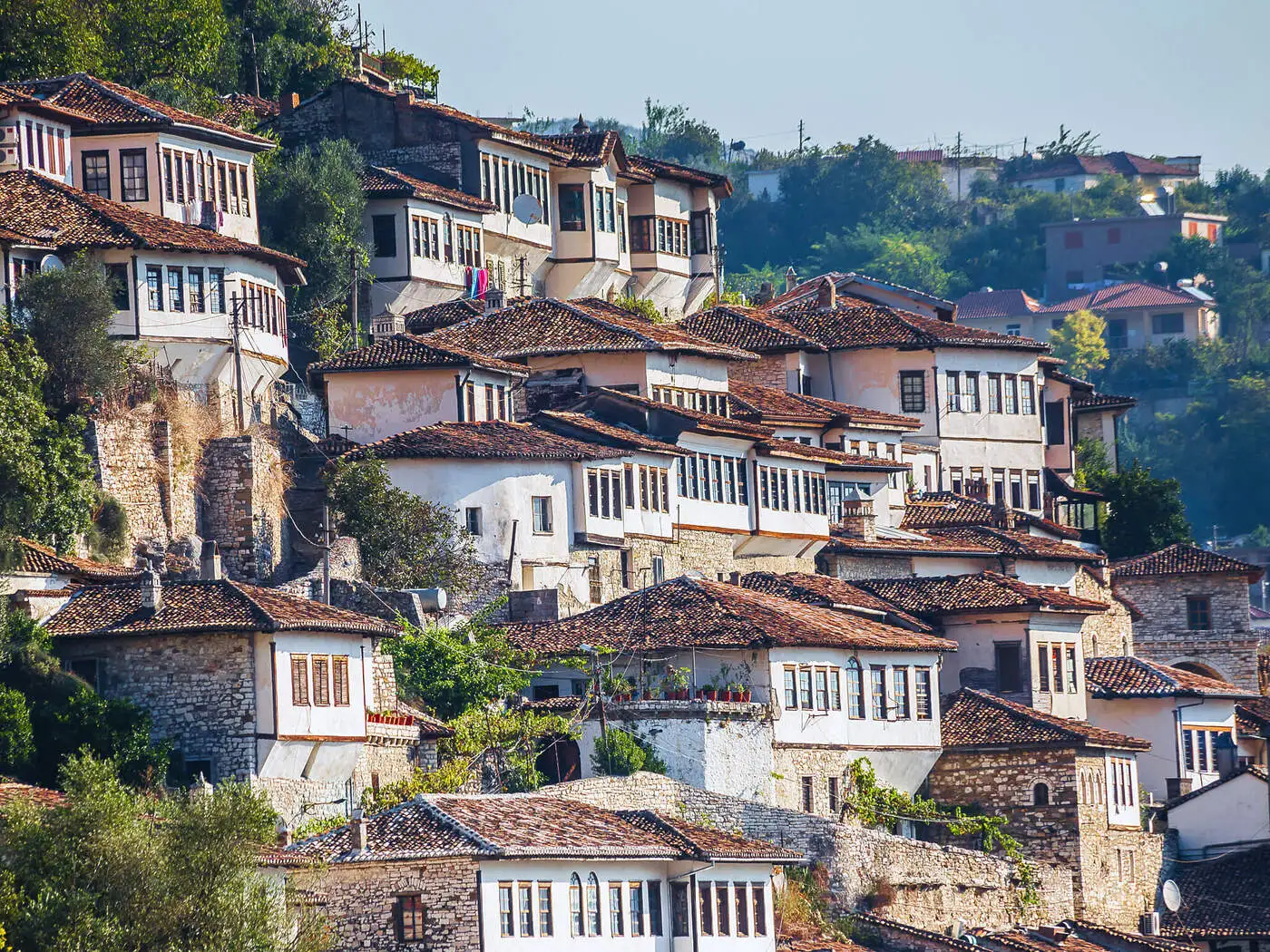
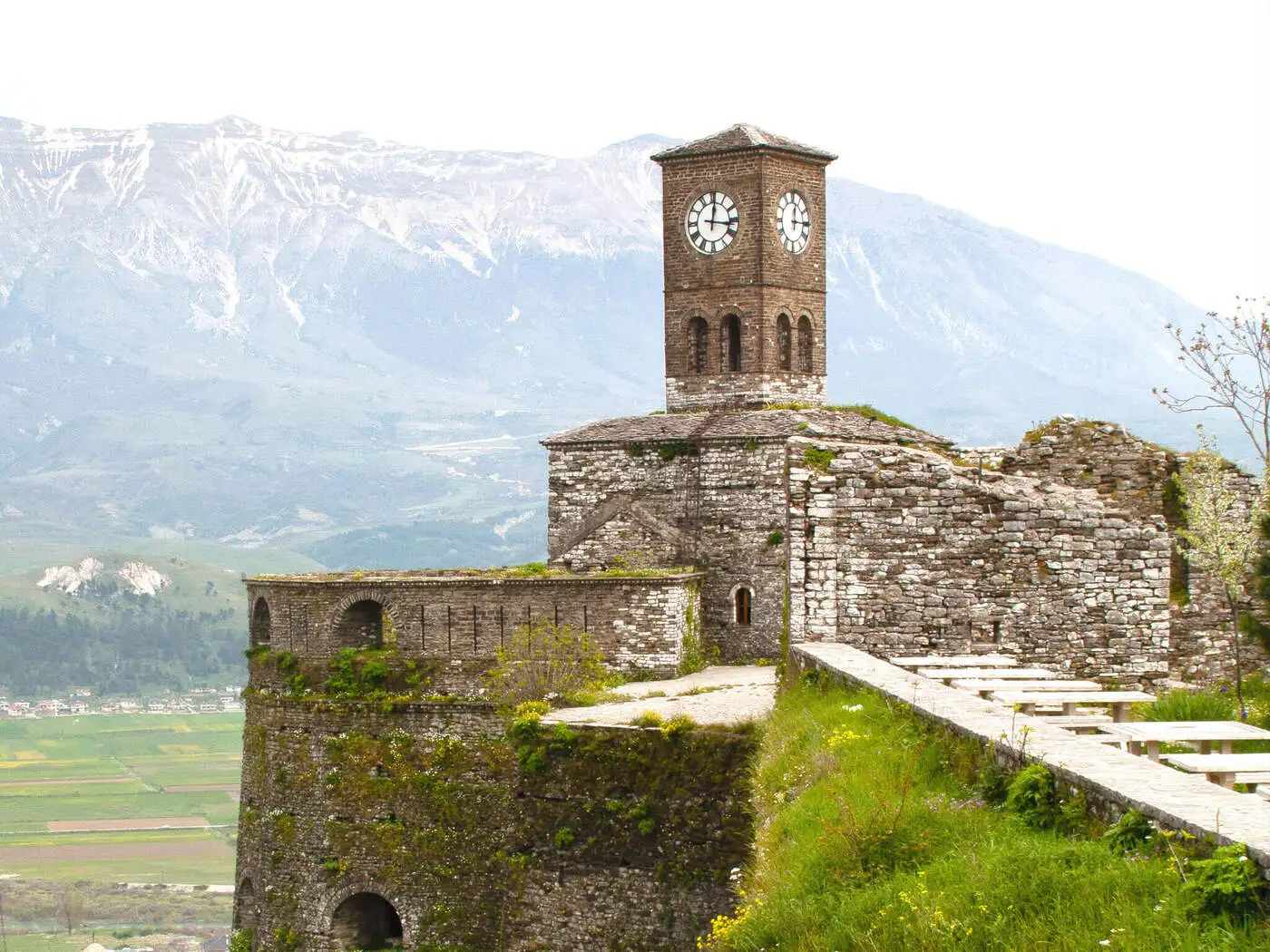
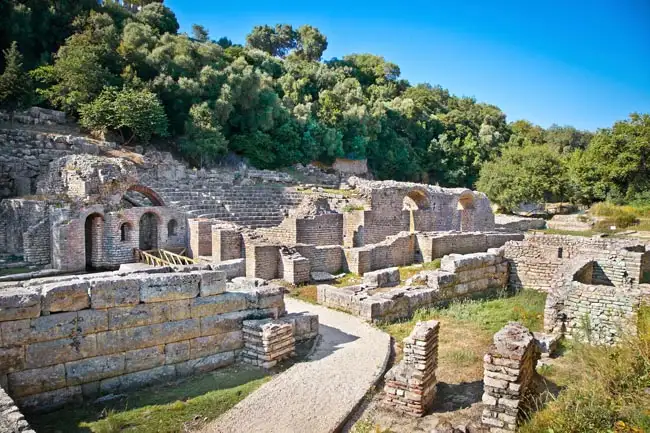
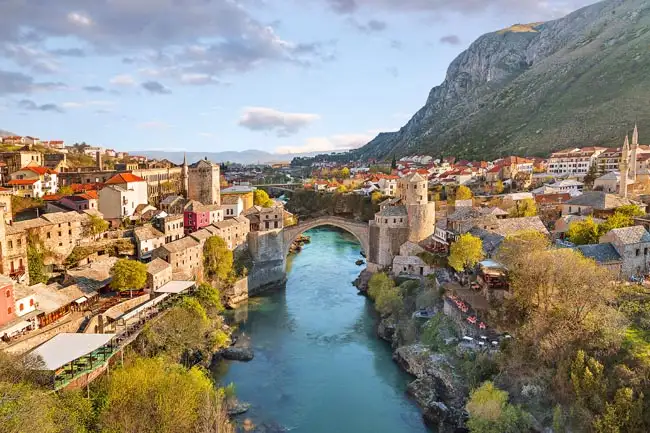
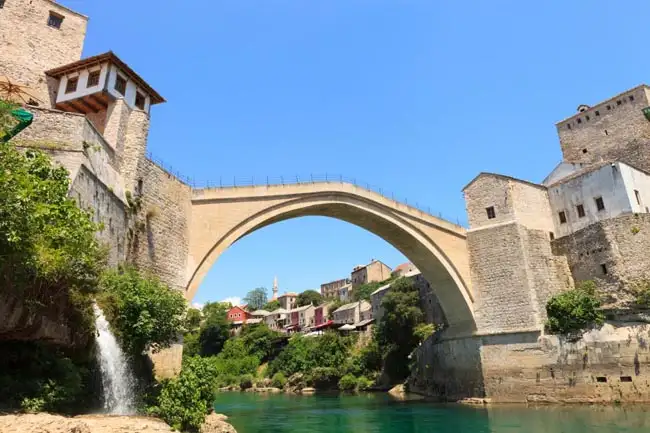
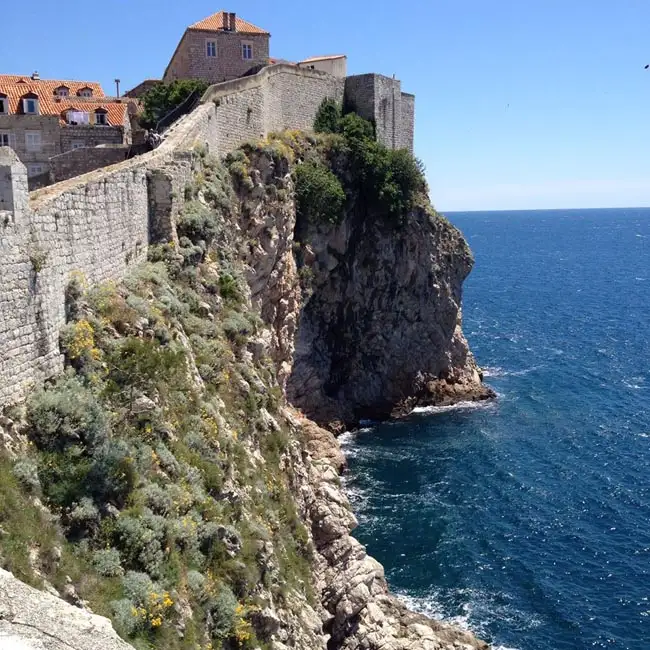
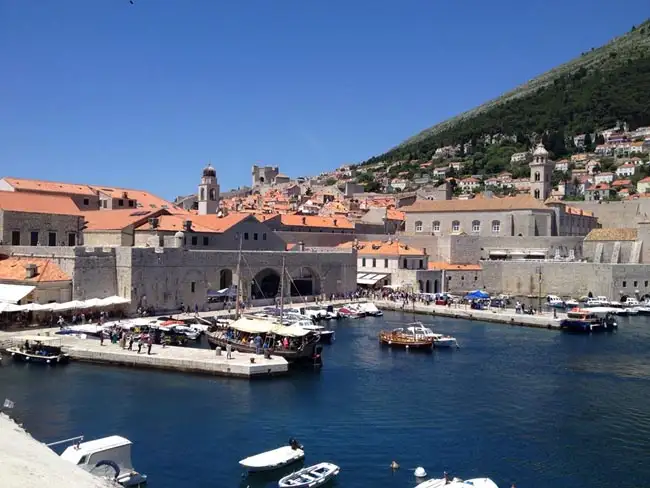
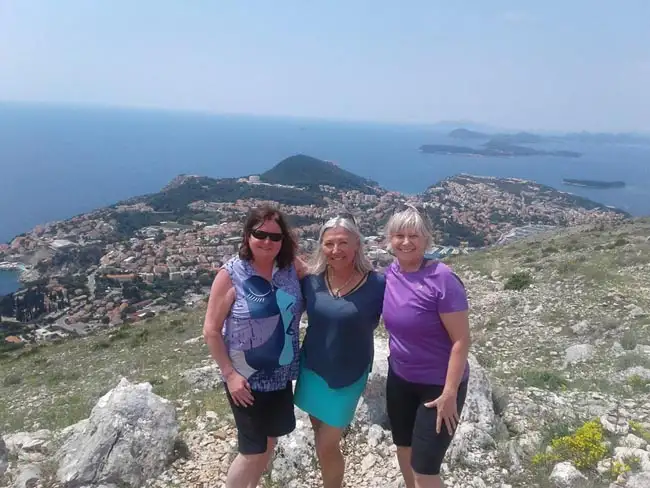

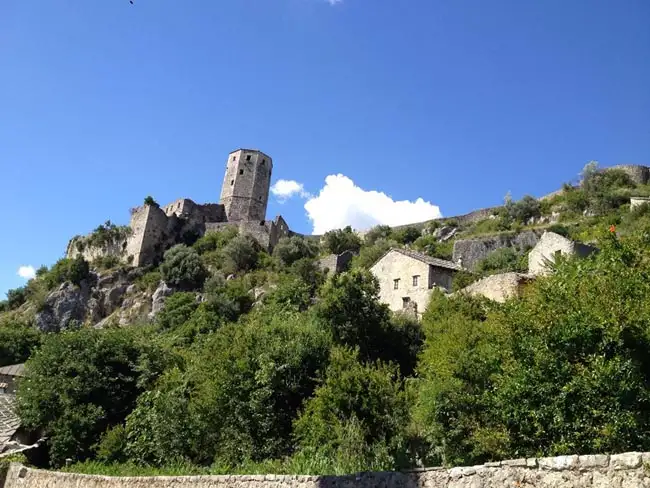

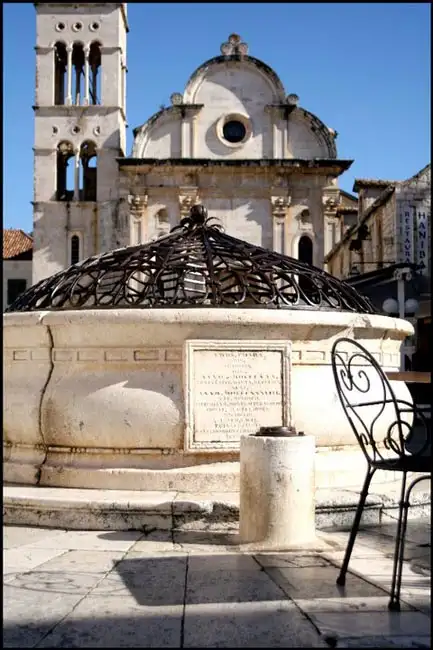
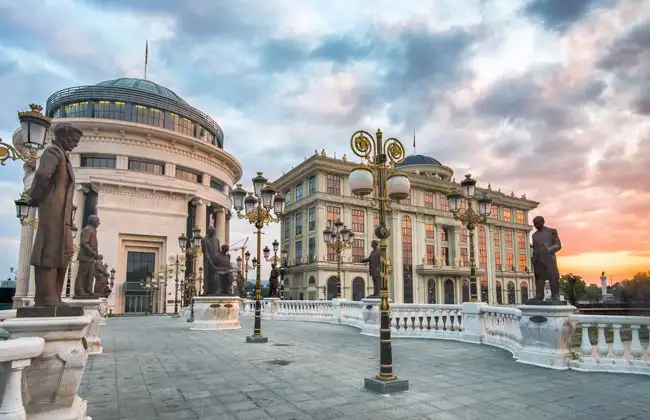
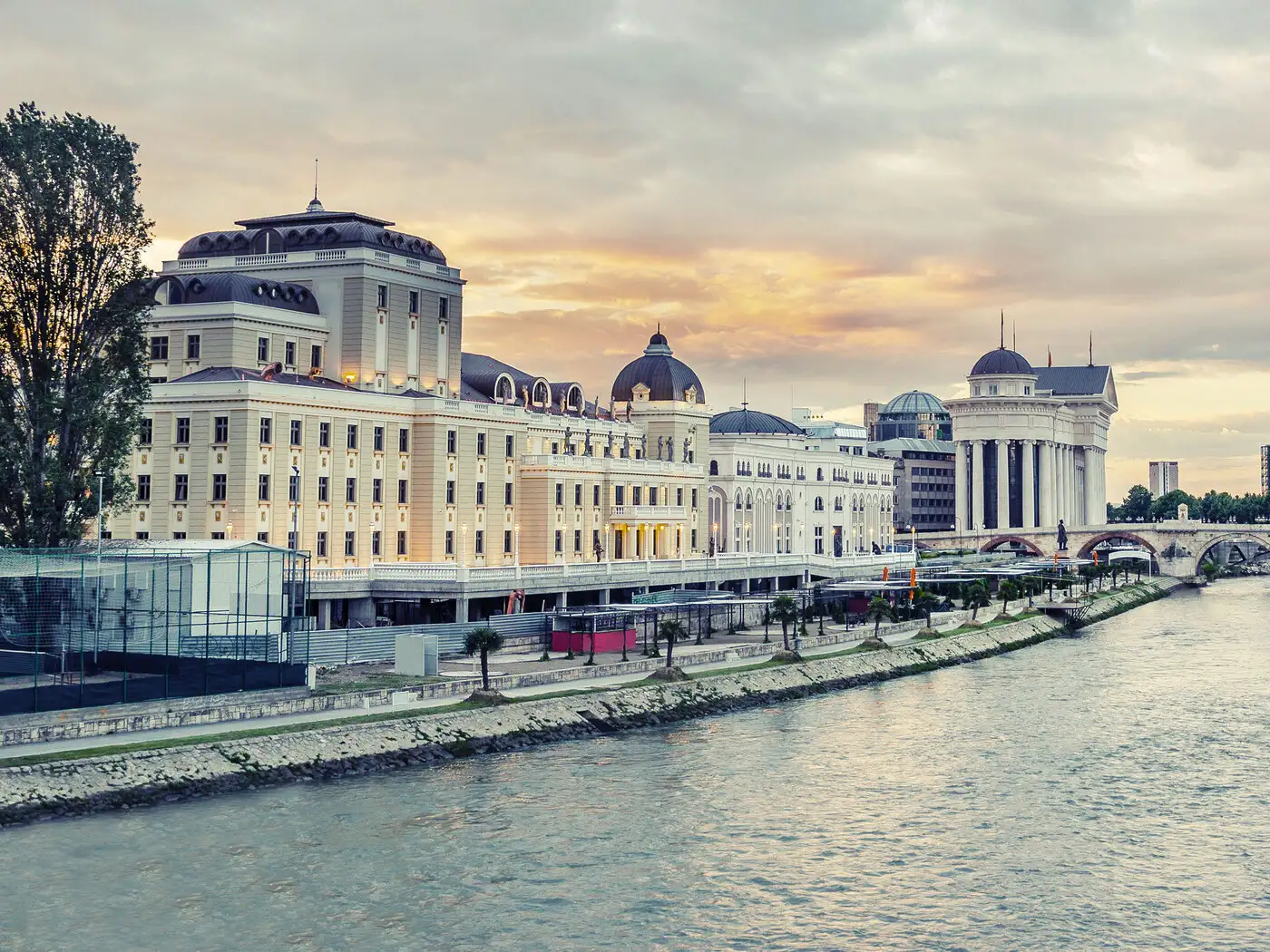

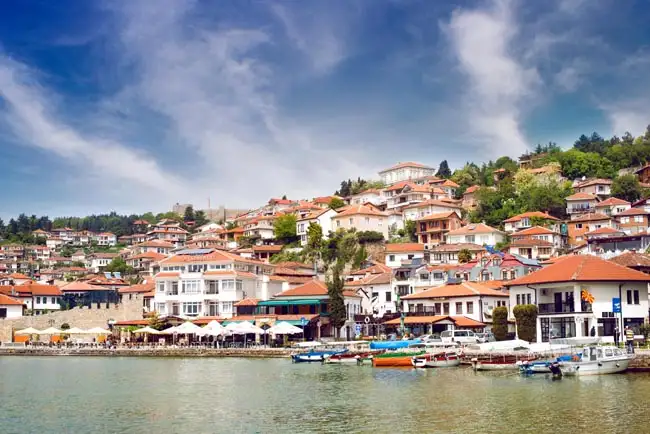
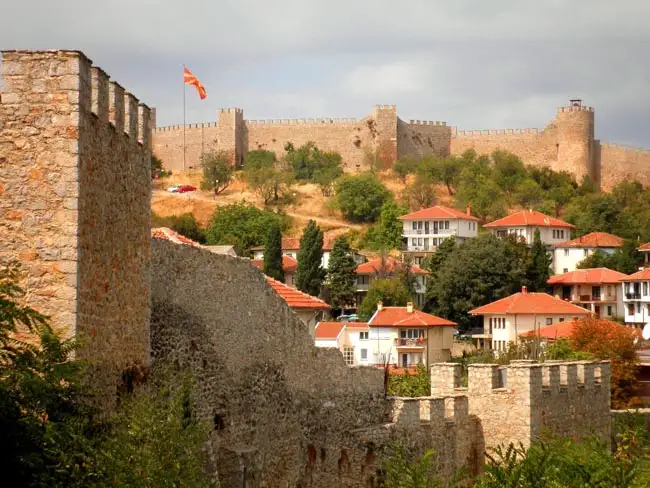
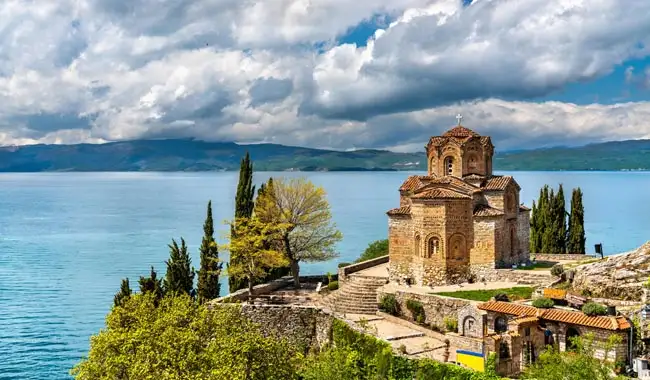

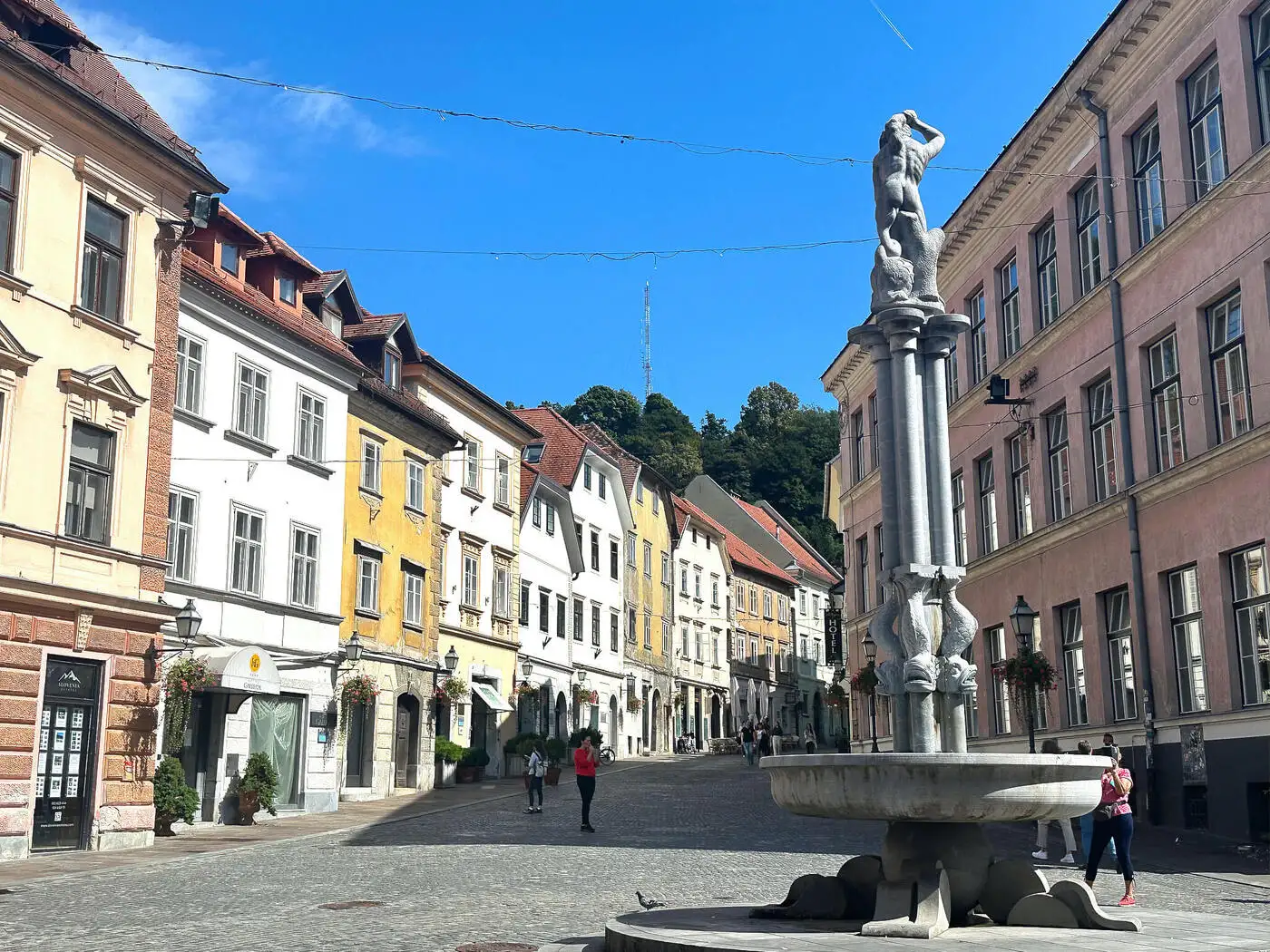
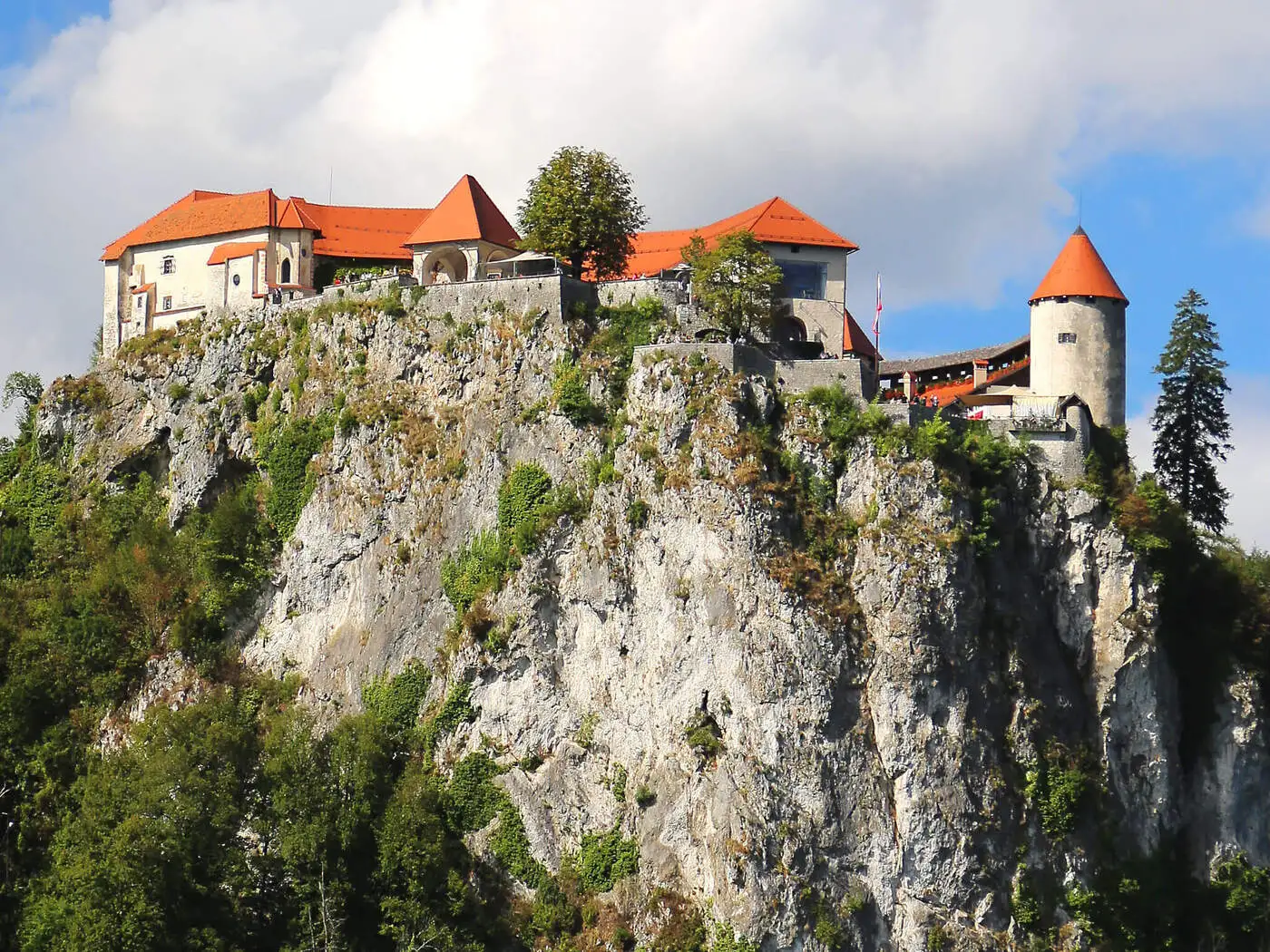
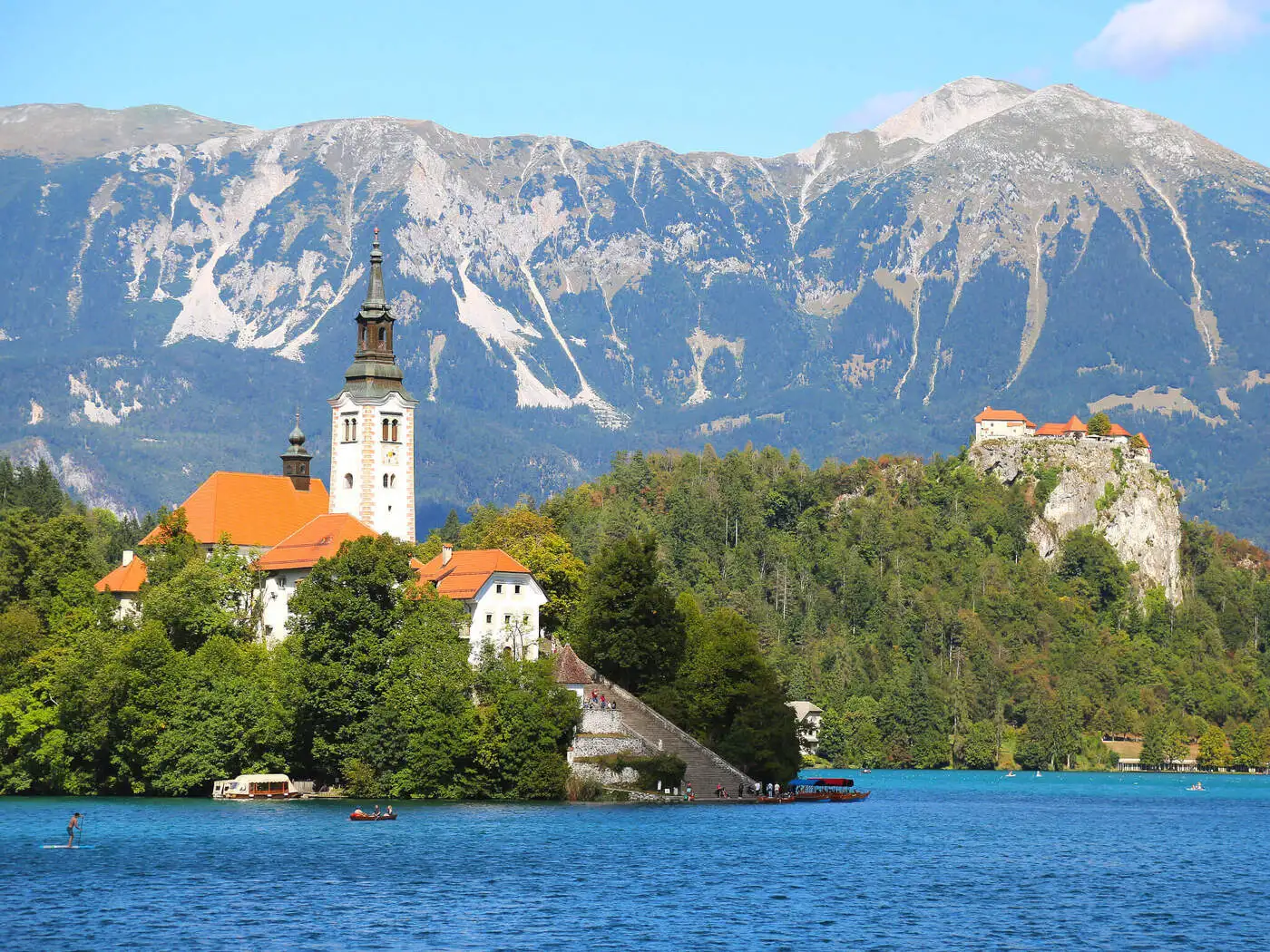
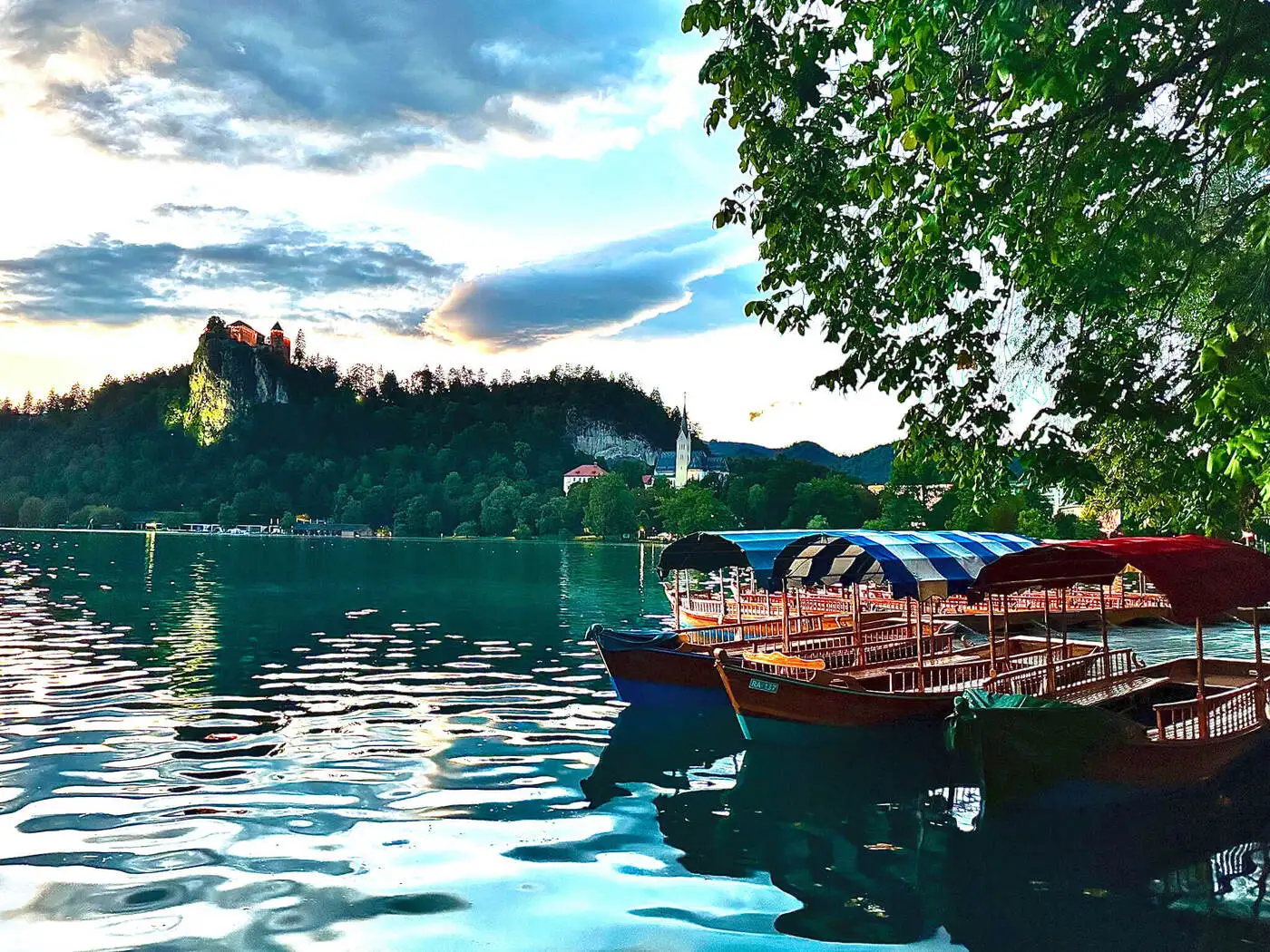
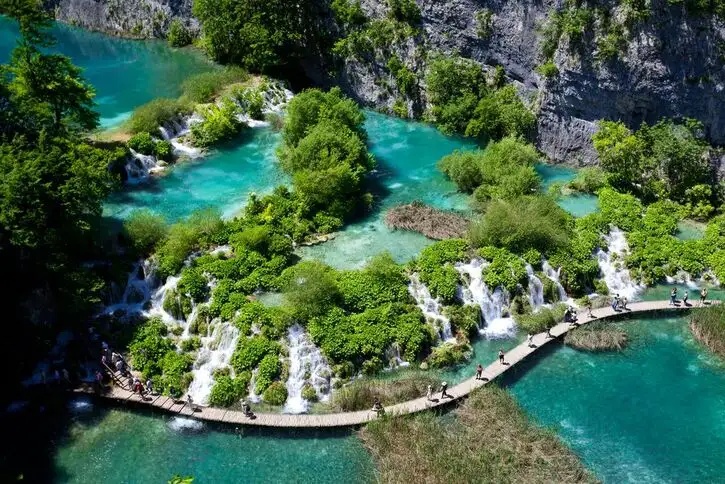
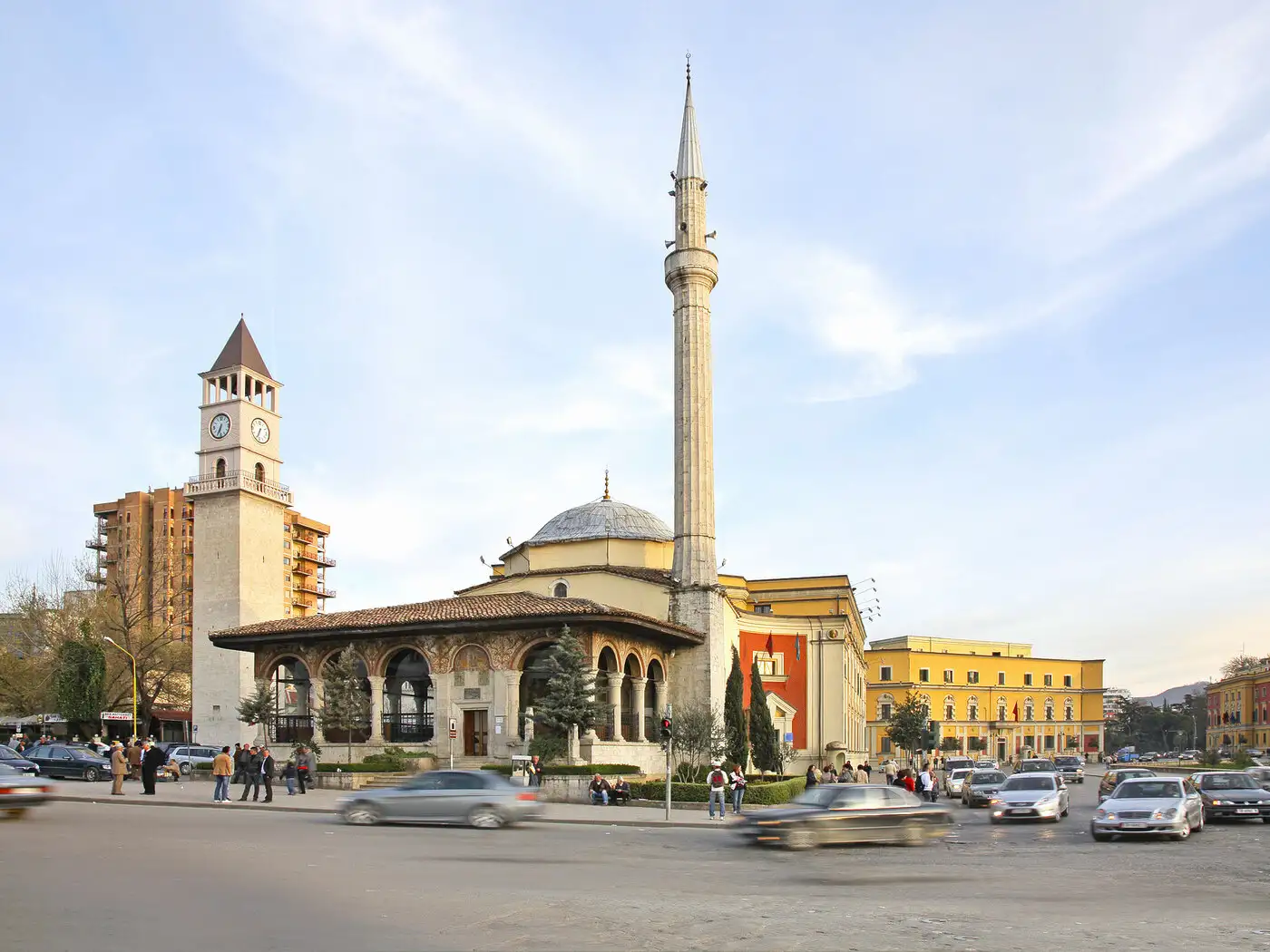
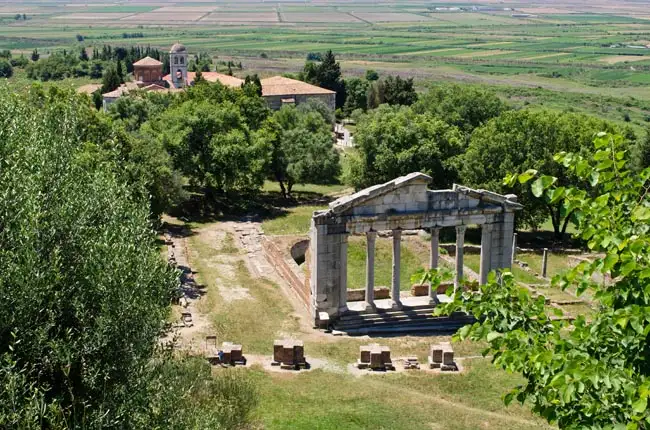
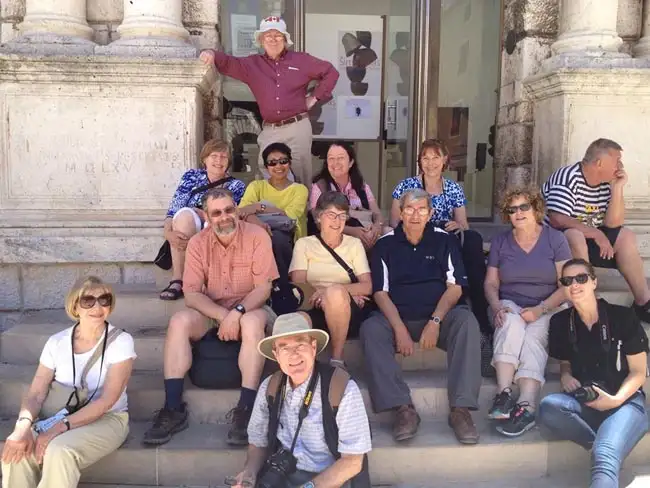
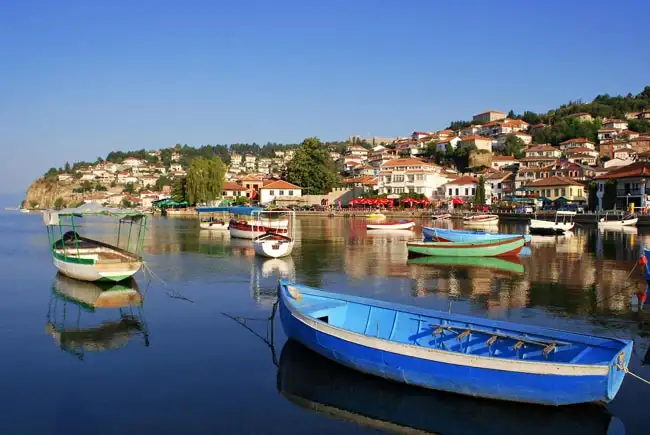

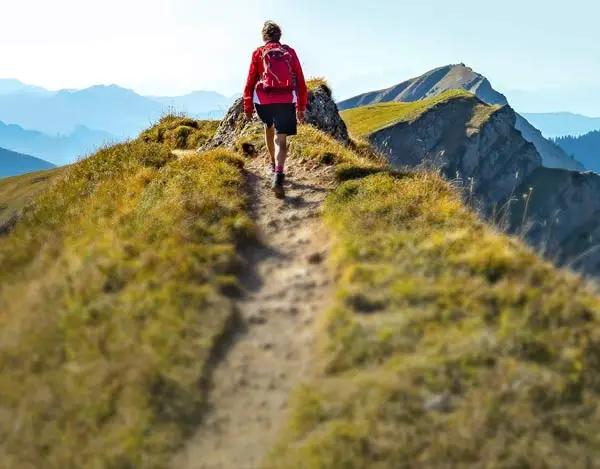
Book This Tour
- Final payment: Due 90 days prior to departure.
- Deposit: A non-refundable $1000 CAD Deposit is required at booking.
- Optional Single Supplement: $2750 CAD (number of singles limited).
(View options forsingle travellers) - Transfering Tour or Date: Transferring to another tour or tour date is only permissible outside of 120 days prior to departure and is subject to a $100 CAD change fee.
(Read our cancellation policy)
Prices below are per person, twin-sharing costs in Canadian Dollars (CAD). Pricing does not include airfare to/from the tour and any applicable taxes.
Frequently Asked Questions
- What is the maximum number of participants on a trip?Most of our tours carry a maximum of 18 participants; some tours (ie hiking tours) top out at 16. In the event that we do not achieve our minimum complement by our 90-day deadline, we may offer group members the option of paying a "small-group surcharge" as an alternative to cancellation. If all group members agree, we will confirm the trip at existing numbers; this surcharge is refundable in the event that we ultimately achieve our regular minimum. If the small group surcharge is not accepted, we will offer a refund of your deposit or a different trip of your choice.
- Can I extend my tour either at the beginning or end? What about stopovers?Yes, you can extend your tour either at the beginning or the end and we can book accommodation in our tour hotel. Stopovers are often permitted, depending on air routing. Stopovers usually carry a "stopover" fee levied by the airline.
- How do I make a reservation? How and when do I pay?The easiest way to make a reservation is via our website; during office hours, you are also more than welcome to contact us by telephone.
A non-refundable deposit is payable at the time of booking; if a reservation is made within 90 days, full payment is required. Some trips require a larger deposit. If international airline bookings require a non-refundable payment in order to secure space or the lowest available fare, we will require an increase in deposit equal to the cost of the ticket(s).
Early enrolment is always encouraged as group size is limited and some trips require greater preparation time.
Once we have received your deposit, we will confirm your space and send you a confirmation package containing your trip itinerary, any visa/travel permit related documents, invoice, clothing and equipment recommendations, general information on your destination(s), and forms for you to complete, sign and return to us. Your air e-tickets (if applicable), final hotel list, final trip itinerary, and instructions on how to join your tour, will be sent approximately 2-3 weeks prior to departure. - What about cancellations, refunds, and transfers?Please review our cancellation policy page for details.
- I am a single who prefers my own room. What is a single supplement?All of our tours have a single supplement for those who want to be guaranteed their own room at each location.
This supplement is a reflection of the fact that most hotels around the world do not discount the regular twin-share rate for a room by 50% for only one person occupying a room. Most hotels will give a break on the price, but usually in the range of 25-30% of the twin-share rate. This difference, multiplied by each night, amounts to the single supplement.
The conventional amount can also vary from country to country and some destinations are more expensive than others for single occupancy. In order to be "single friendly," the supplements we apply are not a profit centre for us and we do our best to keep them as reasonable as possible.
On most tours we limit the number of singles available, not to be punitive, but rather because many hotels allow for only a limited number of singles; some smaller hotels at remote locations also have a limited number of single rooms available.
Please note that most single rooms around the world are smaller than twin-share rooms and will likely have only one bed. - Do you have a shared accommodation program?Yes! If you are single traveller and are willing to share, we will do our best to pair you with a same-gender roommate. On most of our tours, if we fail to pair you, we will absorb the single supplement fee and you will default to a single room at no extra charge. At some destinations, however, where single rooms are not significantly discounted, or not at all, we may apply a "mandatory" single in the event that we cannot find you a share partner. This is usually 50% of the usual supplement, but can be as much as 100%. If applicable, this proviso will be noted on each tour page on this website, on your invoice, and in our tour date/price book (available for download under "Resources").
